|
Monday 9th. May 2016
We were on the bus at about 8:30am and there was gentle rain
falling. The forecast was for rain all day.
We headed off to the city of Saint Emilion, which is a UNESCO
world heritage site. The Romans planted Vineyards in what was to
become Saint-Émilion as early as the 2nd century. The town was
named after the Monk Émilion, a traveling confessor, who settled
in a hermitage carved into the rock there in the 8th century. It
was the monks who followed him that started up the commercial
wine production in the area.
We explored the old part of the city and had a cup of coffee. We
then got on the bus again and headed off to a Chateau de la
Riviere for a wine tasting. Chateau de la Riviere, Fronsac is
40 km northeast of Bordeaux. The Chateau is owned by the
Chinese. It has 20kms of limestone tunnels beneath it in which
are stored 500,000 bottles of wine. All these bottles of wine
have been produced since the former owner sold it in 1962.
We then drove back to Bordeaux and had a walking tour around the
city centre.
We had dinner at the same restaurant we visited last night. I
went down to the water mirror at sunset and took some photos.
Met a young girl from Thailand who was taking the same scene as
I was with her Canon 5D.
|
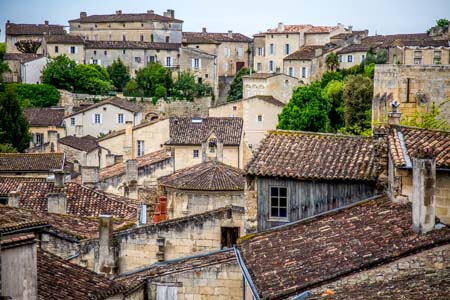
Saint Emilion |
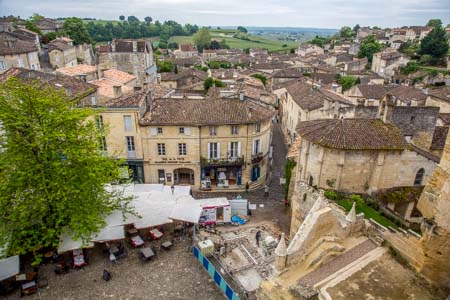
Saint Emilion |
|
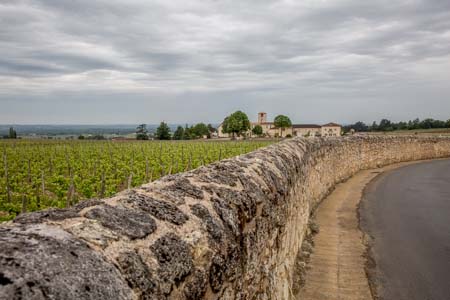
Saint Emilion |
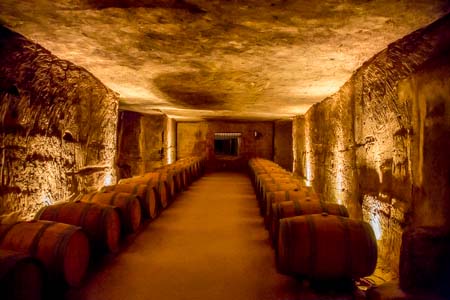
Chateau de la Riviere,
winery, Fronsac |
|

Chateau de la Riviere,
Fronsac |
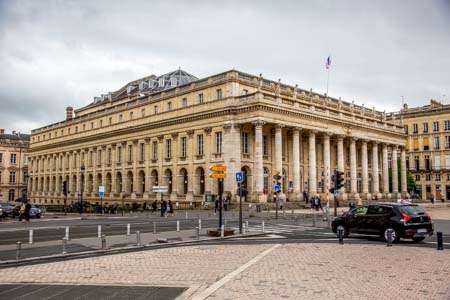
Opera House, Bordeaux |
|
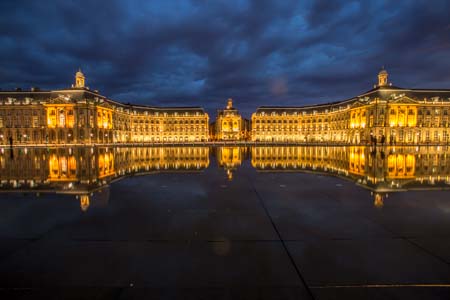
Evening reflections on the water mirror, Bordeaux |
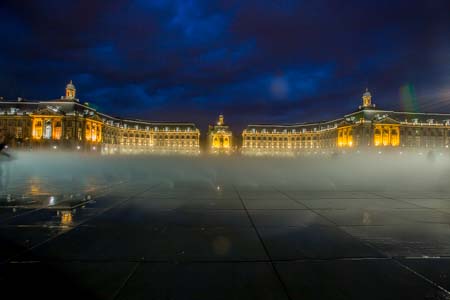
Mist on the water mirror, Bordeaux |
Tuesday 10th.
May 2016
There was not a cloud in the sky when we set off to the city
of Poitiers and then onto Tours.
It took three hours to get to Poitiers where we had two
hours to look around the old town and have some lunch. It
was quite a climb to get up to the old part of the city
which is at the top of a hill. We bought rolls for lunch and
ate them in the town square. The weather was fine, warm and
very pleasant.
While we were waiting at the designated meeting point I
befriended a couple of the local lads and their pitbull
terriers. The leader of the group, hereafter called "Muggins" by me, agreed to
let me take his photo. I was most impressed by his red and
black dyed dreadlocks plaited together at the back and just
hung from the crown of his head. I think the rest of our
tour group and tour leader were waiting for me to be mugged
by these men as this group had had an earlier altercation
with some students.
|
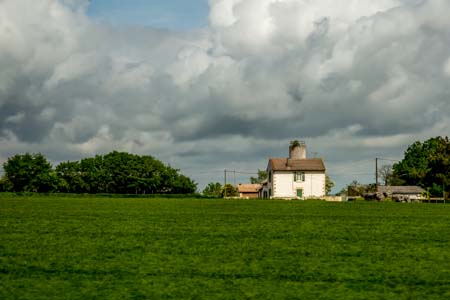
On the road between Bordeaux and Poitiers |
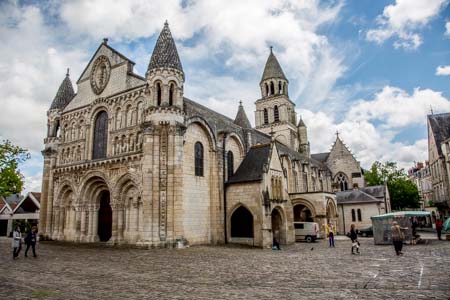
Église Notre-Dame-la-Grande, Poitiers |
|
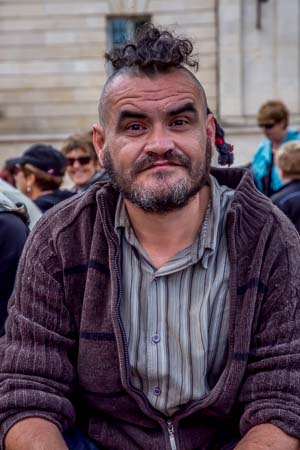
"Muggins" in Poitiers |
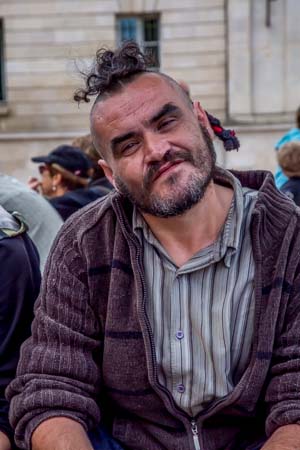
"Muggins" in Poitiers |
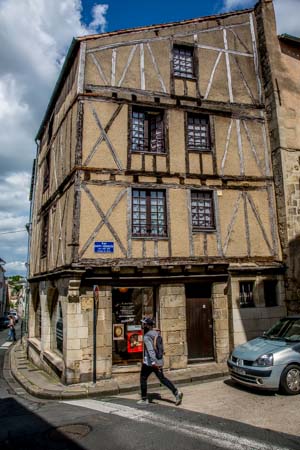
Old building in Poitiers |
We then set off for Tours, which
will be home for the next two nights. We arrived at about
5:00pm and at 5:30pm set off as a group to explore the old
part of the city. Our hotel, the Grand Hotel, is a very old
hotel and the room was dowdy. It has vertical striped wall
paper and a lead light window between the room and the
ensuite bathroom. It is quite dull and the lifts were
temperamental.
On the way we found ourselves in the middle of a political
demonstration of some kind on the street. One of the
students managed to tell us in half English half French that
they were protesting about the austerity cuts being made by
the Prime Minister, and the fact that he had over ruled his
cabinet and forced the laws through. The next moment we
heard loud bangs and tear gas was fired by the police and
the riot squad rushed forwards to remove the students and
their barriers. Unfortunately I was too far away from the
action to get any really good photos and the action
|
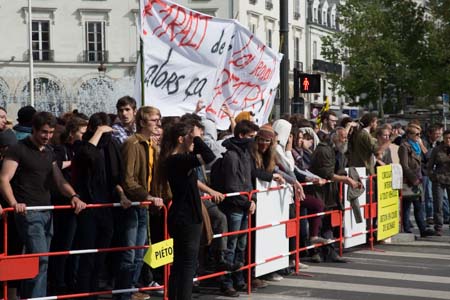
Protesters in Tours |
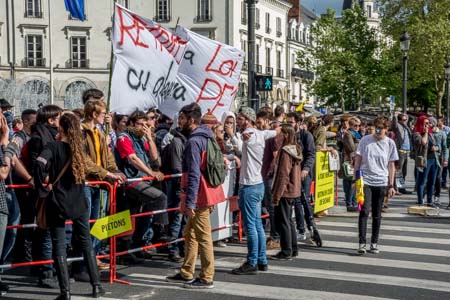
Protesters in Tours |
|
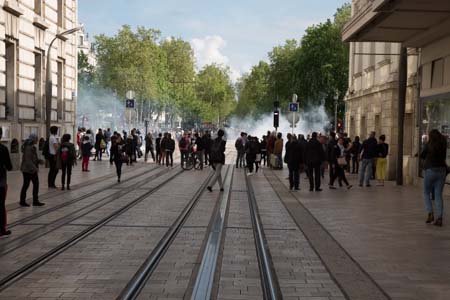
Smoke bombs turn the protest into a riot, Tours |
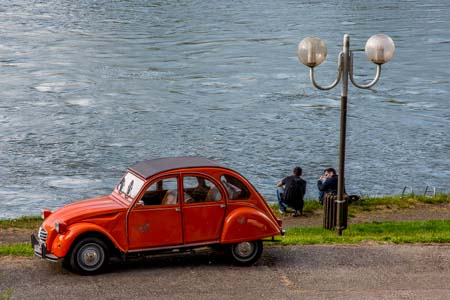
A Citroen beside the River Loire, Tours |
|
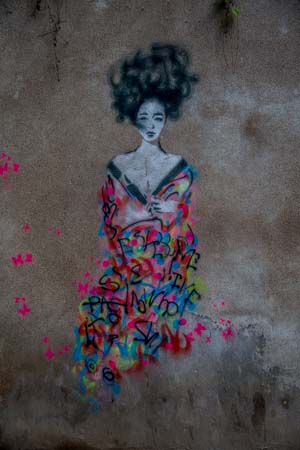
Graffiti in Tours |
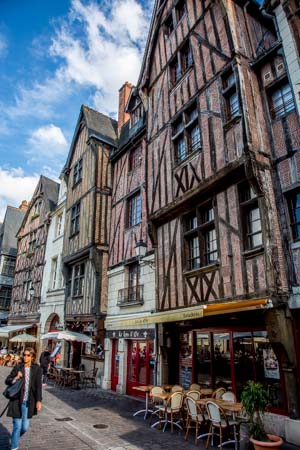
The old part of town, Tours |
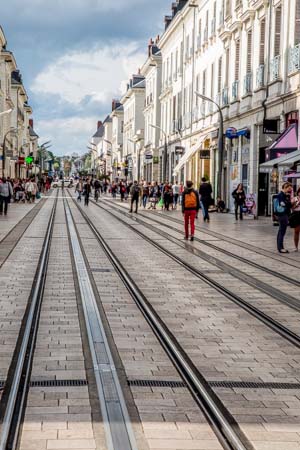
Grammont Avenue, Tours |
We had a drink in the main square
of the old city and then had dinner in a restaurant near the
hotel. We arrived back at our room at about 8:15pm.
Wednesday 11th. May 2016
It was overcast and threatening to rain when we left the
hotel this morning. We drove for about two hours and reached
the huge chateau at Chambord just as the rain started. This
is a huge building, built in the time of Louis XlV. The
rooms were huge and foreboding. This would NOT have been a
nice place to live. It would have been cold and drafty. It
is the antithesis of the statement in Bob Dylan's
The Ballad Of Frankie Lee And Judas Priest -
“It’s not a house . . . it’s a home”
|
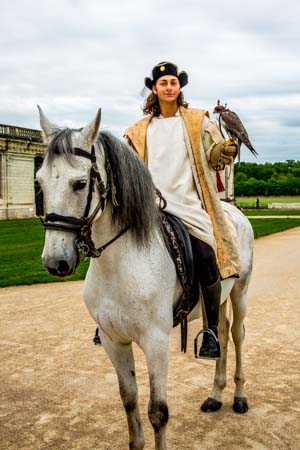
Young gentleman hawker, Chambord |
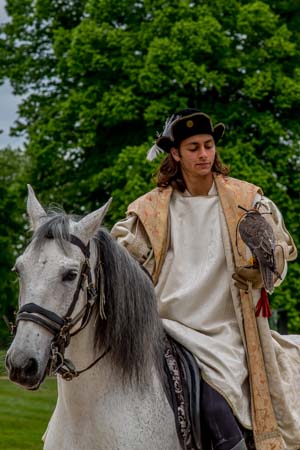
Young gentleman hawker,
Chambord |
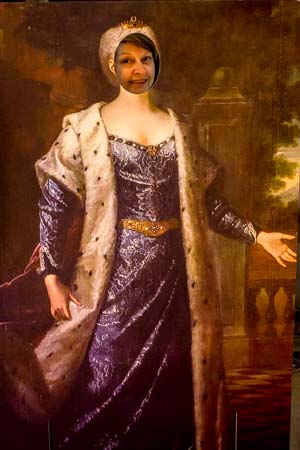
Lady of the Chateau |
|
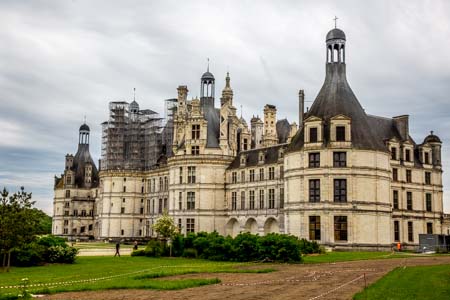
Chateau at Chambord |
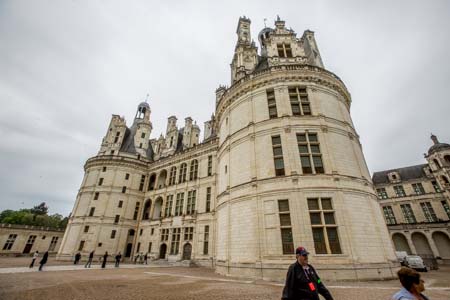
Chateau at Chambord |
|
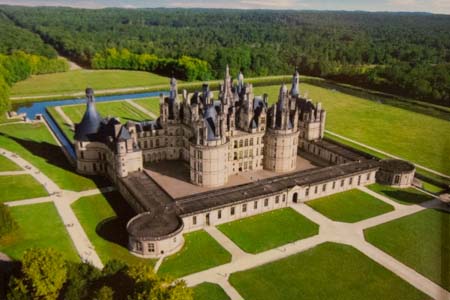
Postcard view of the chateau at Chambord |
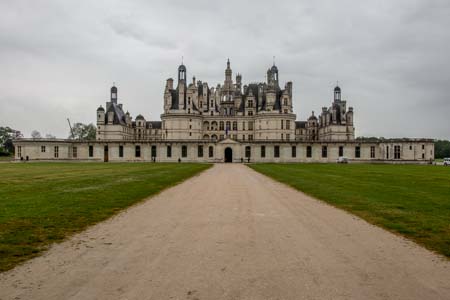
It was raining at the Chateau at Chambord |
We left the chateau and drove to a wine tasting at Caves du
Pere Auguste winery in Chenonceau. After this we had a visit
to the chateau at Chenonceau. This chateau would have been
much more livable.
The "Ladies Castle" was built in 1513 by
Katherine Briçonnet, embellished by Diane de Poitiers and
Catherine de Medici, Chenonceau was saved from the rigors of
the French Revolution by Madame Dupin.
This feminine imprint is everywhere, preserving the
conflicts and wars to make it always been a place of peace.
|

Chateau de Chenonceau |
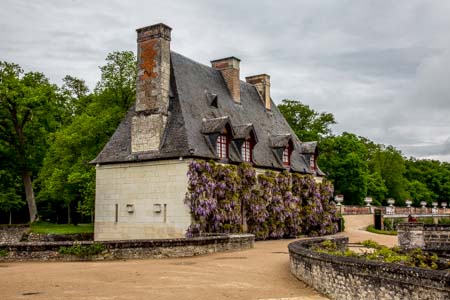
Chateau de Chenonceau |
|
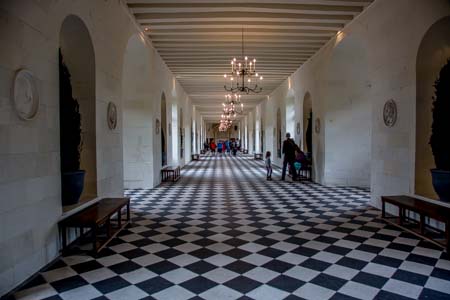
Chateau de Chenonceau |
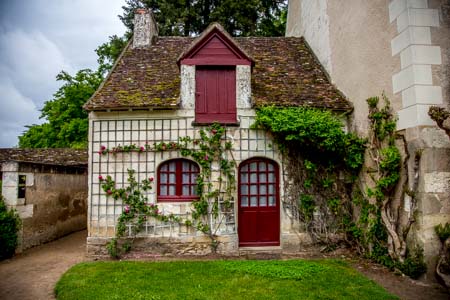
Chateau de Chenonceau |
|
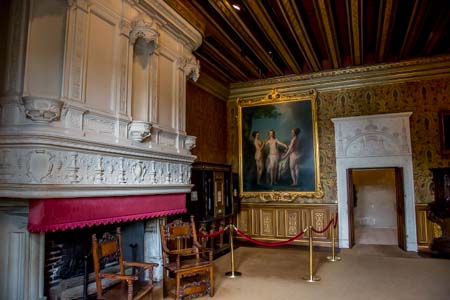
Chateau de Chenonceau |
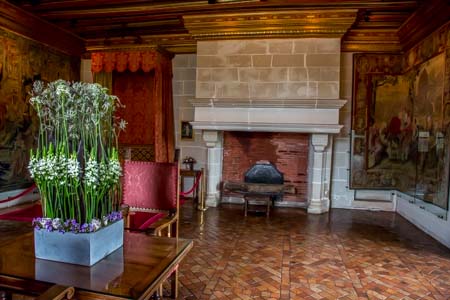
Chateau de Chenonceau |
The Château de Chenonceau possesses an exceptional museum
collection of paintings by great masters: Murillo, Tintoretto,
Nicolas Poussin, Correggio, Rubens, Primaticcio, Van Loo ... And
a rare selection of Flanders Tapestries from the XVI century.
Thursday 12th.
May 2016
It was overcast and raining (13-15˚C)
when we left the Grand Hotel for Mont Saint Michel in Normandy.
The rain became worse the further north we went. We stopped for
an hour or so in Fougères
on the border of Brittany and Normandy for lunch and a quick
look at the chateau.
|
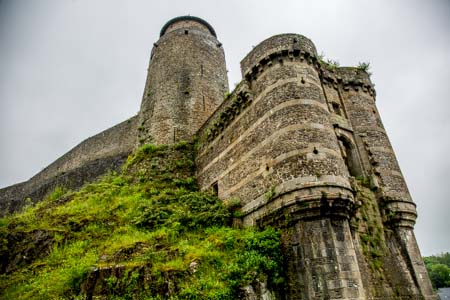
Chateau de Fougères |
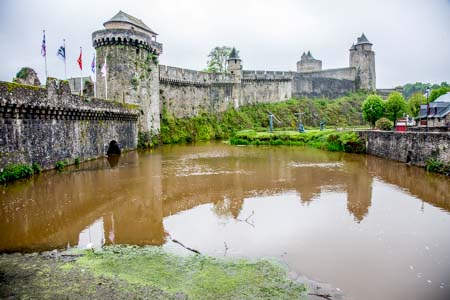
Chateau de Fougères
|
|
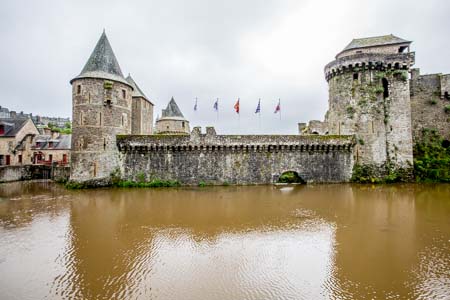
Chateau de Fougères
|
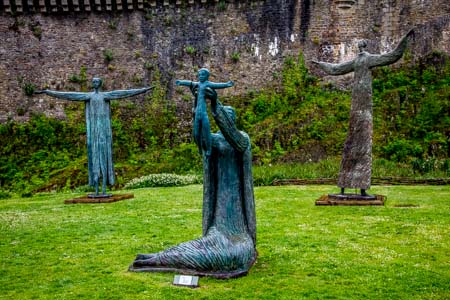
Chateau de Fougères |
Then we pressed on to Mont Saint Michel. As we approached in the
navette (transit bus) we could see hundreds of school children
paddling about in the mud beside the Abbey, as it was low tide.
It was raining when we arrived and the spire of the Abbey was
surrounded in fog as well as scaffolding. We spent an hour or so
on a guided tour and just exploring. Our guide was a fellow
named Tibeau.
|
Mont
Saint-Michel The « Wonder of the Western World »
forms a tower in the heart of an immense bay invaded
by the highest tides in Europe.
It was at the request of the Archangel Michel
« chief of the celestial militia » that Aubert,
Bishop of Avranches built and consecrated a small
church on the 16th October 709. In 966 a community
of Benedictines settled on the rock at the request
of the Duke of Normandy and the pre-Romanesque
church was built before the year one thousand.
In the 11th century, the Romanesque abbey church was
founded over a set of crypts where the rock comes to
an apex, and the first monastery buildings were
built up against its north wall.
In the 12th century, the Romanesque monastery
buildings were extended to the west and south.
In the 13th century, a donation by the king of
France, Philip Augustus, in the wake of his conquest
of Normandy, enabled a start to be made on the
Gothic section of the "Merveille ": two three-storey
buildings, crowned by the cloister and the
refectory.
In the 14th century, the Hundred Years War made it
necessary to protect the abbey behind a set of
military constructions, enabling it to hold out
against a siege lasting 30 years.
In the 15th century, the Romanesque chancel of the
abbey church, broken down in 1421 was replaced by
the Gothic Flamboyant chancel.
With Rome and Saint Jacques de Compostelle, this
great spiritual and intellectual centre, was one of
the most important places of pilgrimage for the
Medieval occident. For nearly one thousand years
men, women and children went there by roads called
« paths to paradise » hoping for the assurance of
eternity, given by the Archangel of judgement « Peseur
des ames ».
The Abbey was turned into a prison during the days
of the French Revolution and Empire, and needed to
be restored before the end of the 19th century.
With the celebration of the monastic's 1000th
anniversary, in the year 1966 a religious community
moved back to what used to be the abbatial
dwellings, perpuating prayer and welcome the
original vocation of this place. Friars and sisters
from "Les Fraternités Monastiques de Jerusalem" have
been ensuring a spiritual presence since the year
2001.
At the same time as the abbey was developing a
village grew up from the Middle Age. It flourished
on the south-east side of the rock surrounded by
walls dated for the most part from the Hundred Years
war. This village has always a commercial vocation.
UNESCO has classed the Mont Saint-Michel as a world
heritage in 1979 and this mecca of tourism welcomes
more than 2,5 millions visitors a year. |
|
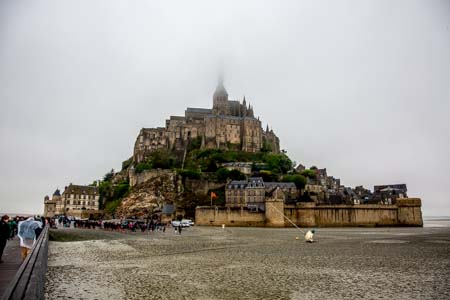
Mont Saint Michel as we approached it |
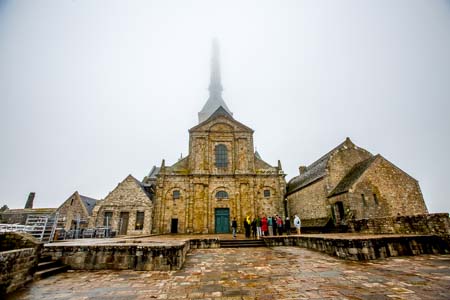
Saint Michel Abbey with the spire in the fog |
|
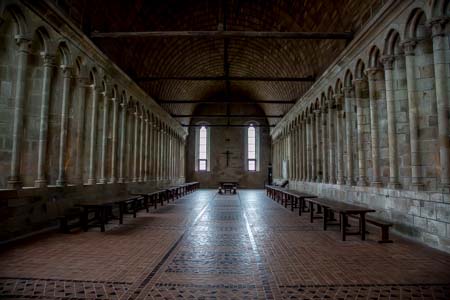
The Refectory, Saint Michel Abbey |
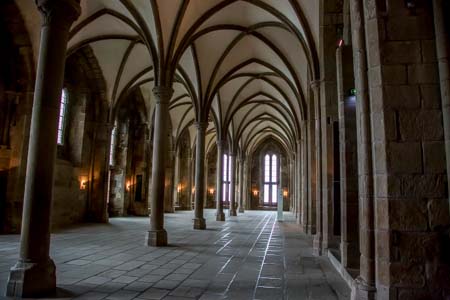
Saint Michel Abbey, The kitchen (I think) |
|
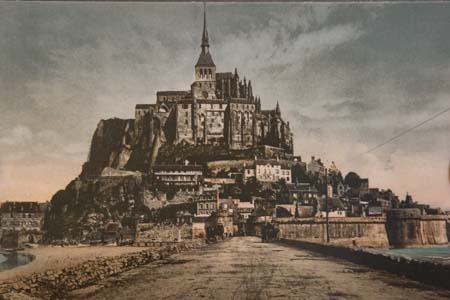
How the post cards depict Mont Saint Michel |
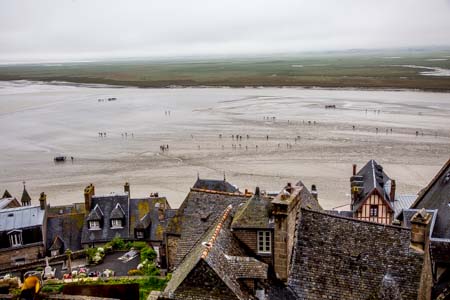
Children playing in the mud flats below Mont Saint
Michel |
At around 5:30pm we headed off to the Hotel Ibis in Caen
which will be our home for the next two nights.
Friday 13th. May 2016
It was cold and overcast when we left the hotel.
It was bitterly cold at Arromanches where
the Allies built a massive mobile
port facility which they floated in from across the English
channel in the fortnight after D day, 6th. June 1944.
Apparently the Germans believed no allied invasion would be
successful unless the Allies had a port. So they fiercely
guarded the ports along the northern coast of France, never
expecting a portable facility to be brought in. The planning and
execution of the plan is almost beyond believe. There were some
massive concrete barges built using millions of tonnes of
concrete, many of which were sunk to form a harbour wall. Some
of the harbour wall is still intact out on the horizon, while
some of the barges lie marooned on the beach.
|
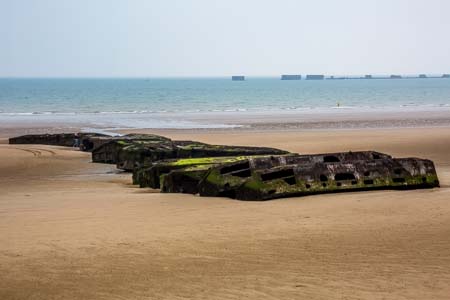
Precast Concrete debris on the beach |
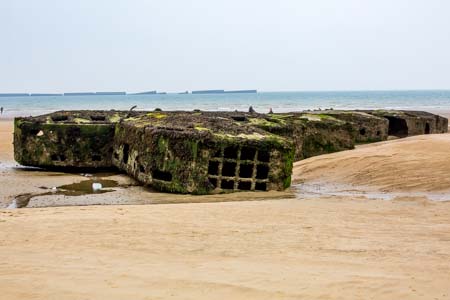
Precast concrete debris on the beach |
|
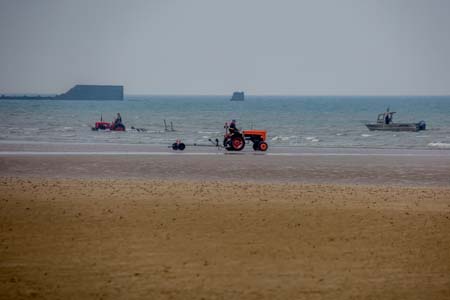
Small tractors launching fishing boats |
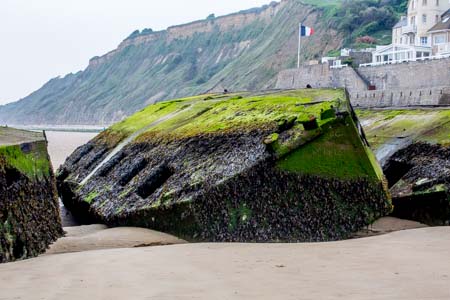
Precast concrete barges on the beach |
|
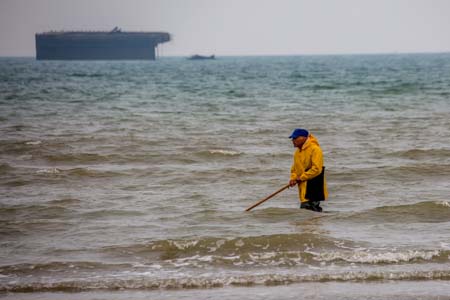
Was he mine sweeping? |

Looking for cockles? |
We then moved from Gold Beach to
the American memorial and cemetery overlooking Omaha Beach.
|
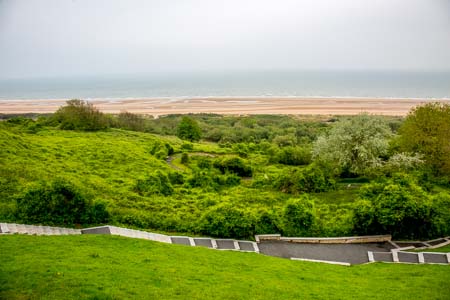
Omaha Beach |
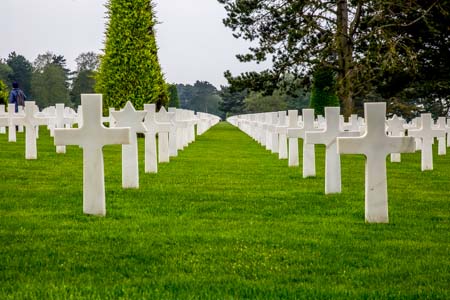
American Cemetery at Omaha Beach |
We moved on to Pointe du Hoc.
This was the site where elements of the 2nd. Ranger Battalion
scaled the cliffs, seizing the German artillery which was
hazardous to the landings on adjacent Omaha and Utah Beaches.
|
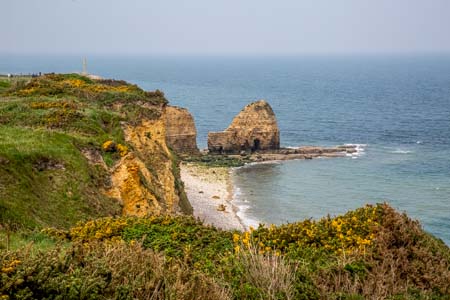
Cliffs at Pointe du Hoc |
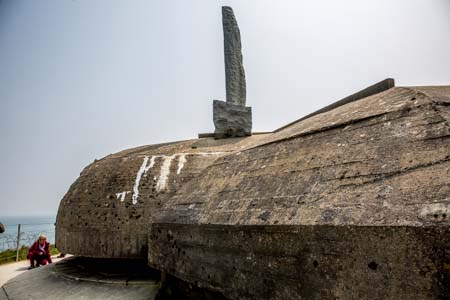
German gun emplacements at Pointe du Huc |
The the next stop was to see the
remains of the old German gun emplacements and the craters
around them which show testimony to the massive bombardment
during the invasion. We then traveled to the German memorial and
cemetery just outside the village of la Cambe.
Then drove to Bayeux, had a late lunch before having a look at
the Bayeux Tapestry. It is 70 metres long and would have taken
an eternity to make. It depicts the struggles of Harold
Godwinson, the Earl of Wessex and the son in law of Edward the
Confessor. Upon Edward's death, Harold became King, his reign
culminating with his defeat to William the Conqueror in The
Battle of Hastings, 1066.
|
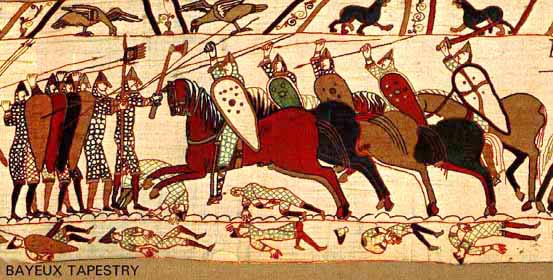
Part of the Bayeux Tapestry |
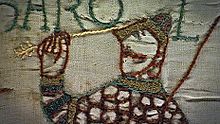
Harold with an arrow in his eye, Bayeux tapestry |
Saturday 14th.
May 2016
It was overcast when we left the hotel in Caen with an estimated
temperature range of 9 - 13˚C
today. After about 4 hours of bus travel we arrived at the
Australian cemetery and war memorial at Villers-Bretonneux.
The Villers-Bretonneux Memorial is an Australian National
Memorial. It commemorates all of the Australian soldiers who
fought in France and Flanders from 1916 to 1918 during the Great
War of 1914-1918.
The Memorial serves also as a place of commemoration for those
who died, and most particularly it is the place where all the
names of those Australian officers and men who were killed in
action in France and who have no known grave are commemorated.
|
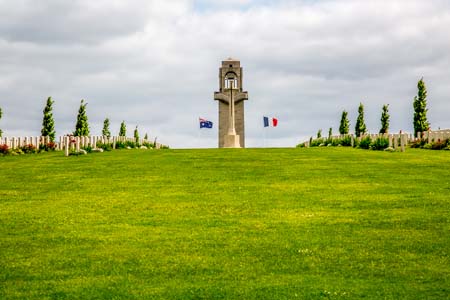
The Villers-Bretonneux
Memorial and Cemetery |
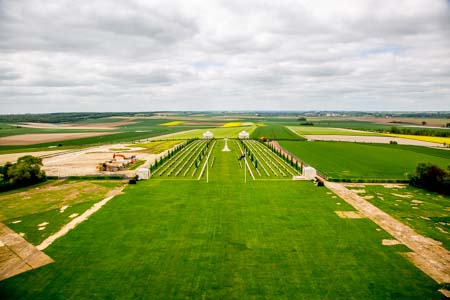
The Villers-Bretonneux
Memorial and Cemetery |
We spent about an hour here before
moving into the town and having lunch at a local restaurant.
After lunch we visited the Franco - Australian war museum in
Villers - Bretonneux. From there is was a short half hour trip
to our hotel for the night in Amiens.
We then walked into the old part of town and explored the Cathedral
Basilica of Our Lady of Amiens which is the 19th largest church
in the world. Medieval cathedral builders were trying to
maximize the internal dimensions in order to reach for the
heavens and bring in more light. In that regard, the Amiens
cathedral is the tallest complete cathedral in France, its
stone-vaulted nave reaching an internal height of 42.30 metres.
It also has the greatest interior volume of any French
cathedral, estimated at 200,000 cubic metres. The cathedral was
built between 1220 and c.1270
|
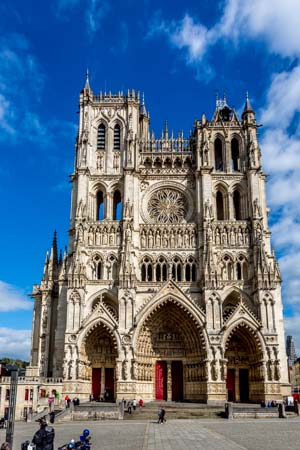
Amiens Cathedral |
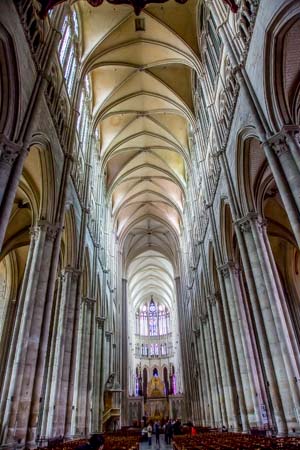
Amiens Cathedral |
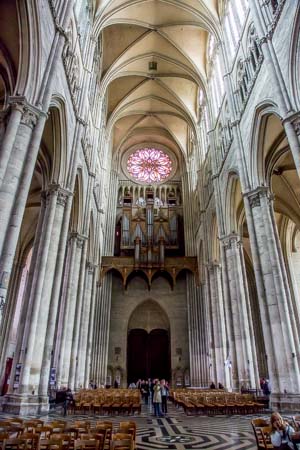
Amiens Cathedral |
Sunday 15th. May 2016
We left Amiens and headed towards the village of Giverny to
see Claude Monet's garden. It was quite spectacular with a lot
of colour and reflections in the water as one may expect from
seeing his paintings. It was extremely crowded and it was then
that we discovered that there is a long weekend in France this
weekend.
|
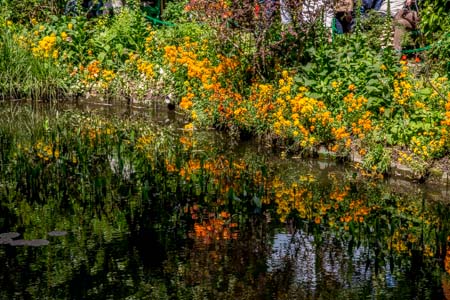
Monet's water garden, Giverny |
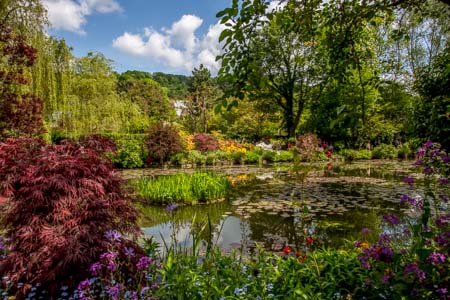
Monet's water garden, Giverny |
|
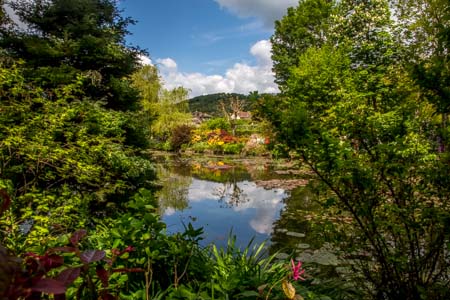
Monet's water garden, Giverny |
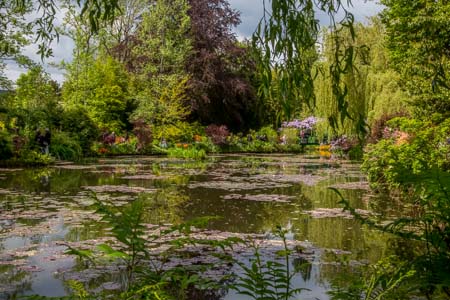
Monet's water garden, Giverny |
There was an interesting face in the queue while we waited
for lunch
We arrive in Paris and went to Carlton's Hotel on Boulevard
Rochechouart which becomes Boulevard
de Clichy about 50 metres down the road. At about 5:15pm
Fernando took us on a walking tour around Montmartre and to see
Sacre Couer. It was very crowded and there were a few buskers
playing to entertain the crowds in the surrounding area.
|
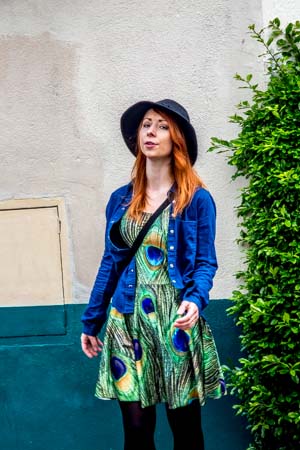
Busker in Montmartre |
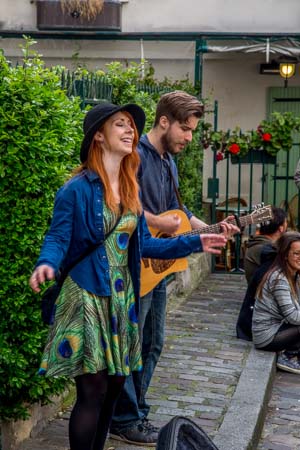
Buskers in Montmartre |
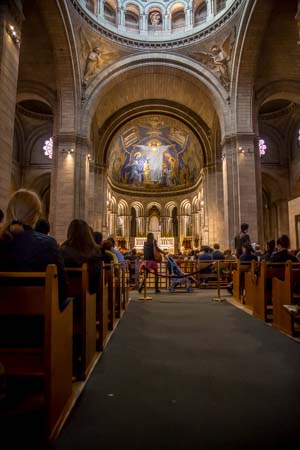
The Basilica of the Sacré-Cœur |
|
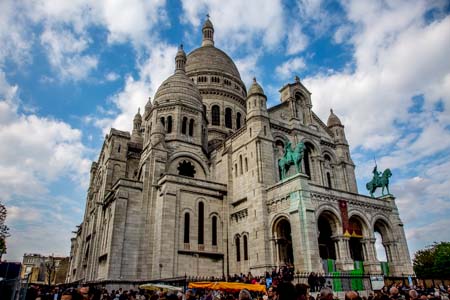
The Basilica of the
Sacré-Cœur |
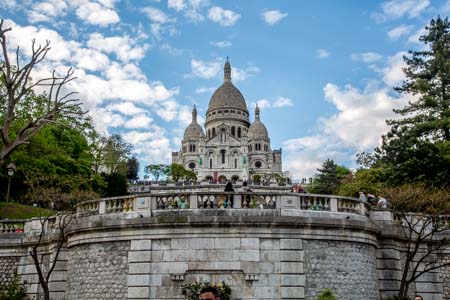
The Basilica of the
Sacré-Cœur |
We had dinner at La Marmite Restaurant across the road from
the hotel. Just after sunset we walked down to Moulin Rouge and
took some photos of the windmill. Both sides of our street from
the hotel to the Moulin Rouge have multitudes of sex shops and
sex shows advertised in brightly coloured lights.
|
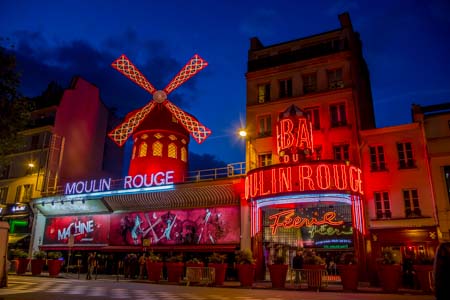
Moulin Rouge, Boulevard de
Clichy |
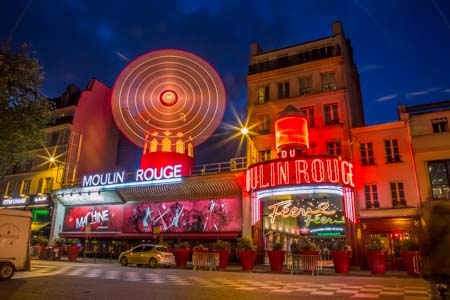
Moulin Rouge, Boulevard de
Clichy |
|
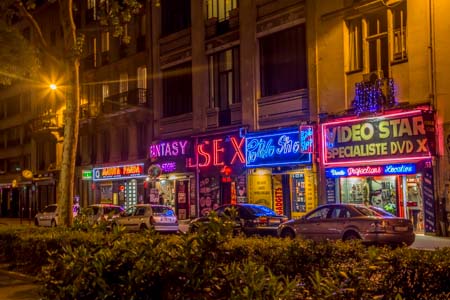
Nightlife along Boulevard de
Clichy |
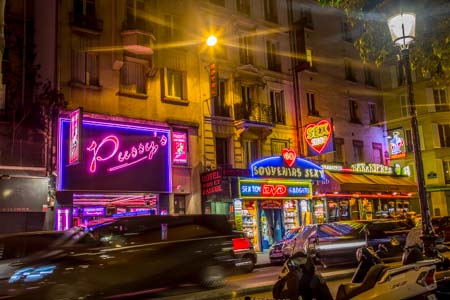
Nightlife along Boulevard de
Clichy |
|